Chapter 4
The M60’s Last Hurrah
By Kater Miller, Curator
Featured artifact: M60A1 Tank (1991.515.1)
The ground campaign of Operation Desert Storm kicked off on 24 February 1991. This ground assault was a short affair, lasting roughly 100 hours before U.S. president George H. W. Bush called for a ceasefire. It was not the first time that U.S. Marines engaged in ground combat during the Gulf War, as they had previously executed daring artillery raids and fought in the Battle of al-Khafji (29 January–1 February 1991). For the Marines, the ground war consisted of infiltrating a barrier berm that separated Saudi Arabia from Kuwait, punching through two obstacle belts, and advancing to liberate Kuwait City.
During Operation Desert Shield, the leadup to Desert Storm, the Marines prepared to oppose the Iraqi Army, whose soldiers had dug in in southern Kuwait. Marines stationed on amphibious assault ships in the Persian Gulf threatened to perform an amphibious landing on the Kuwaiti coast, thereby keeping the Iraqis there from reinforcing the obstacle belt. Much of the United States-led Coalition shifted west while the looming threat of the Marines at sea held the Iraqi Army in place.
A large berm stood on the border of Saudi Arabia and Kuwait. The berm was constructed before Desert Shield as a method to limit the wanderings of the Bedouin tribes. Though not constructed as an impediment for a military force, it would still need to be breached by the Marines. Beyond the berm, the Iraqi military had built two obstacle belts in Kuwait. These belts were comprised of barbed wire, mines, tank traps, and ditches that were designed to slow an assault, making enemy forces vulnerable to artillery attack. Iraqi president Saddam Hussein, who thought a Coalition assault would unfold in Kuwait, believed that he could grind the war into a bloody stalemate in the same way that the Iran-Iraq War had unfolded in the 1980s. However, U.S. Army general H. Norman Schwarzkopf Jr., commander of U.S. Central Command, planned for the Marines, flanked on either side by multinational Arab forces, to push the Iraqis out of Kuwait. Meanwhile, a large Coalition force would push north into Iraq through its lightly defended border with Saudi Arabia and then swing to the east to cut off Iraqi troops fleeing Kuwait in a maneuver called the “Hail Mary” or the “Left Hook.”
Though a massive air bombing campaign preceded the ground assault, the Iraqi Army remained a formidable force. The Marine ground forces faced a determined, dug-in, and armored enemy. Major General J. Michael Myatt, commanding general of the 1st Marine Division, organized four task forces (TF): TF Papa Bear, TF Ripper, TF Grizzly, and TF Taro. TF Papa Bear and TF Ripper were mechanized and had the 1st and 3d Tank Battalions, respectively, attached to their organizations to provide an armored punch as they began their assaults on the Iraqi obstacle belts. Marine engineers masterfully prepared the way into all of the obstacle belts, earning high praise from General Schwarzkopf.
Just after midnight on 24 February, the 3d Tank Battalion crossed the border and stopped in an assembly area just short of the first of two obstacle belts in occupied Kuwait. At around 0400 local time, TF Ripper began assaulting across the first obstacle belt, with the 3d Tank Battalion in the lead. By early afternoon, TF Ripper had penetrated both obstacle belts and entered the al-Burqān oil field. They engaged Iraqi defenses in the oil field that afternoon and destroyed 11 Iraqi tanks. The task force then turned left to advance on Ahmad al-Jaber Air Base.
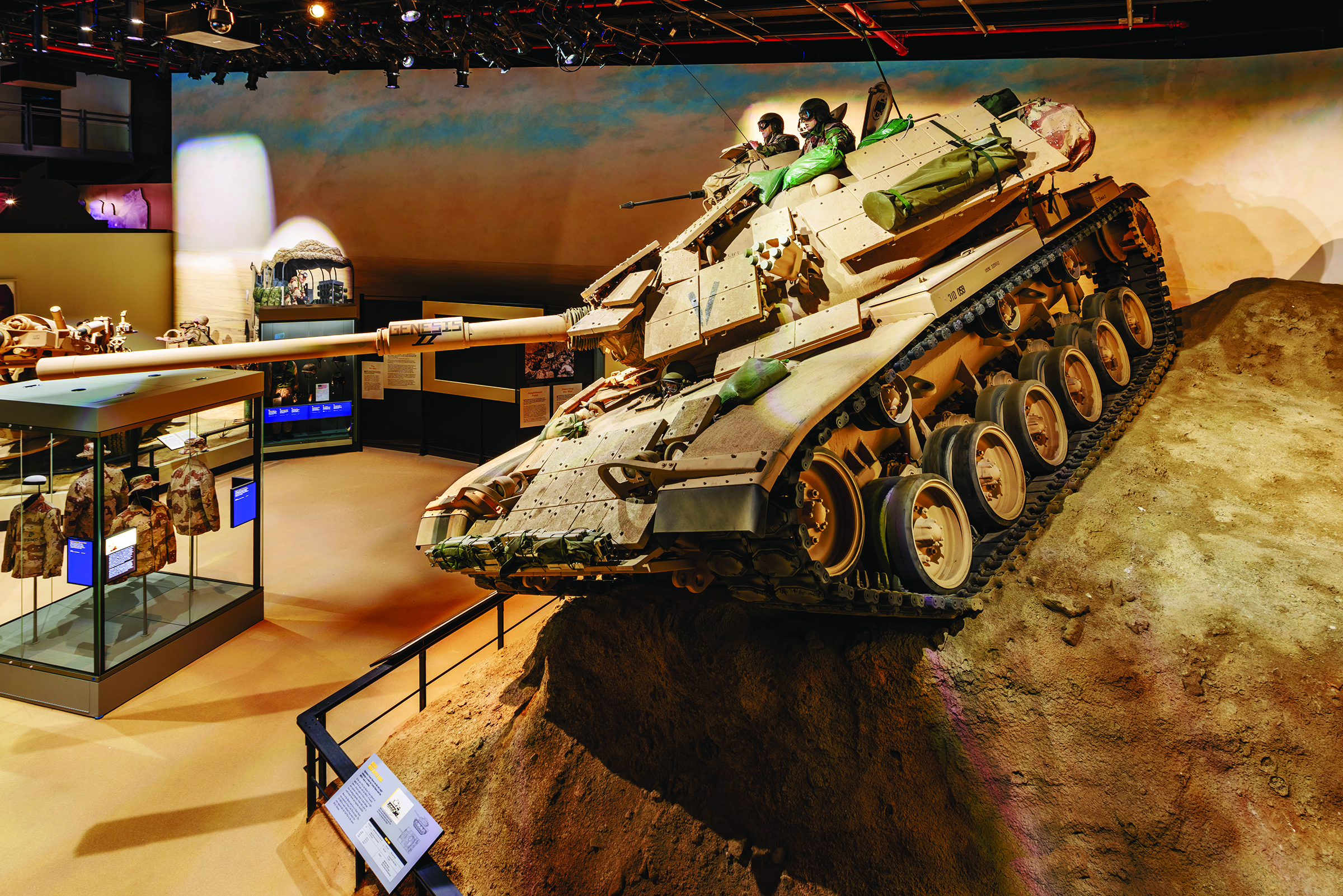
Genesis II on display at the National Museum of the Marine Corps.
Photo by Jose Esquilin, Marine Corps University Press.
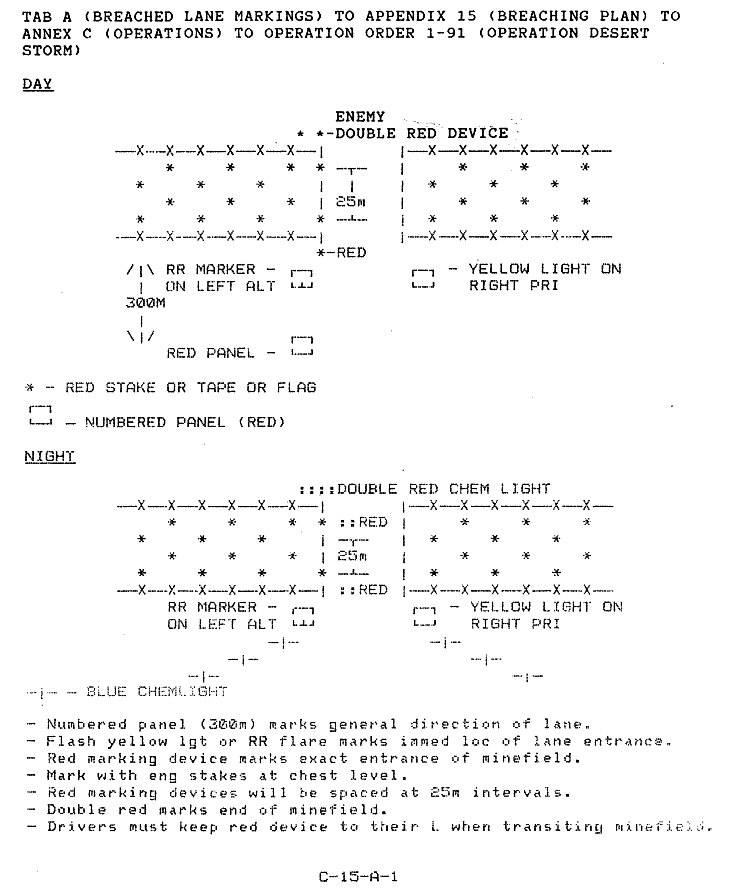
Marines watched the obstacle belts and practiced breaching operations in the months before the ground assault began. Operation Order 1-91 outlined the procedures for marking and transiting minefields in Kuwait.
Official U.S. Marine Corps Order.
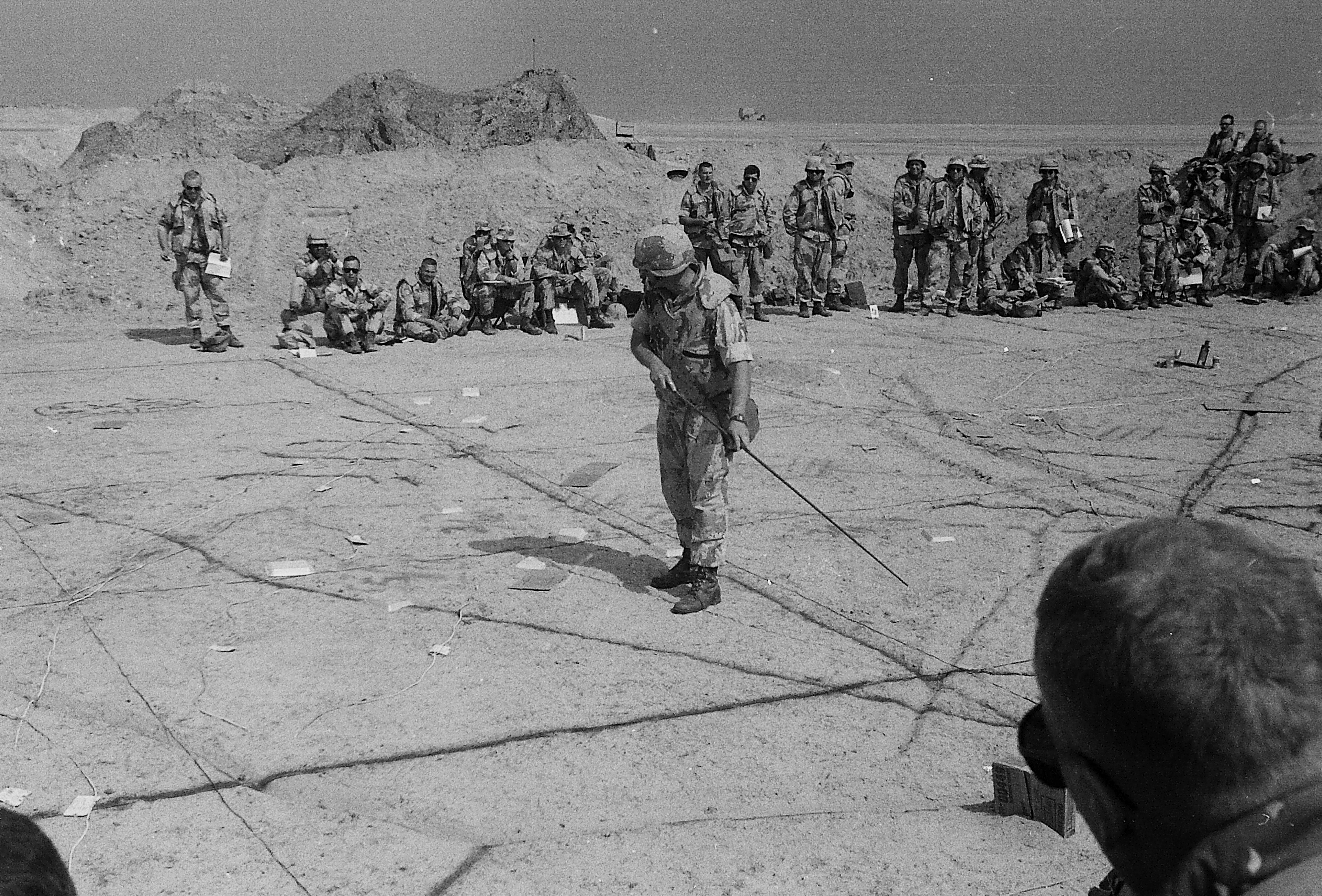
Marines study a sand table map of the obstacle belts in Kuwait. They needed to breach the obstacle belts quickly to avoid being caught in Iraqi artillery barrages and armored counterattacks while unable to maneuver.
Courtesy of Michael O’Neal.
The Marines’ rapid breach of the Iraqi obstacle belt surprised everyone except the Marines themselves. As soon as the Marines had arrived in the Persian Gulf during Desert Shield, they began studying the obstacle belts and practiced breaching them. The rehearsals worked; the Marines went through the obstacles so quickly that General Schwarzkopf was afraid that Iraqi units would be able to escape from Kuwait before coalition troops were in place to block their retreat. The chairman of the Joint Chiefs of Staff, U.S. Army general Colin L. Powell, received a phone call explaining that the Marines had smashed through both lines, forcing him to pressure U.S. Army leaders to catch up. Many Army units inside Iraq had reached their objectives by the late morning on 24 February and expected no more movement until the following day. The Marines’ success forced them to resume their advance.
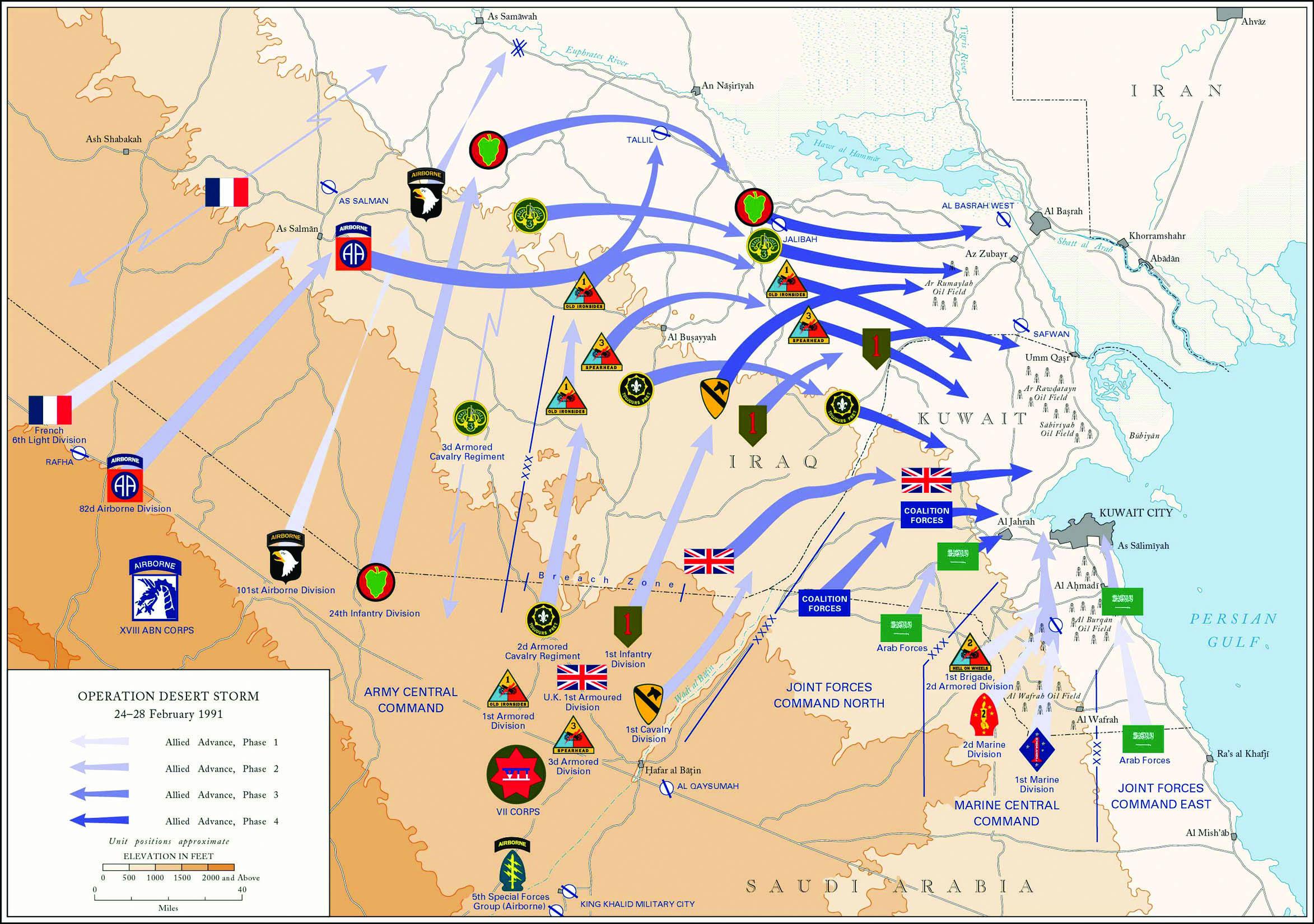
The movement of Coalition forces in the famous “Hail Mary” or “Left Hook” of the ground campaign. Coalition forces blocked the escape route for Iraqi troops that remained in Kuwait.
U.S. Army Center for Military History.
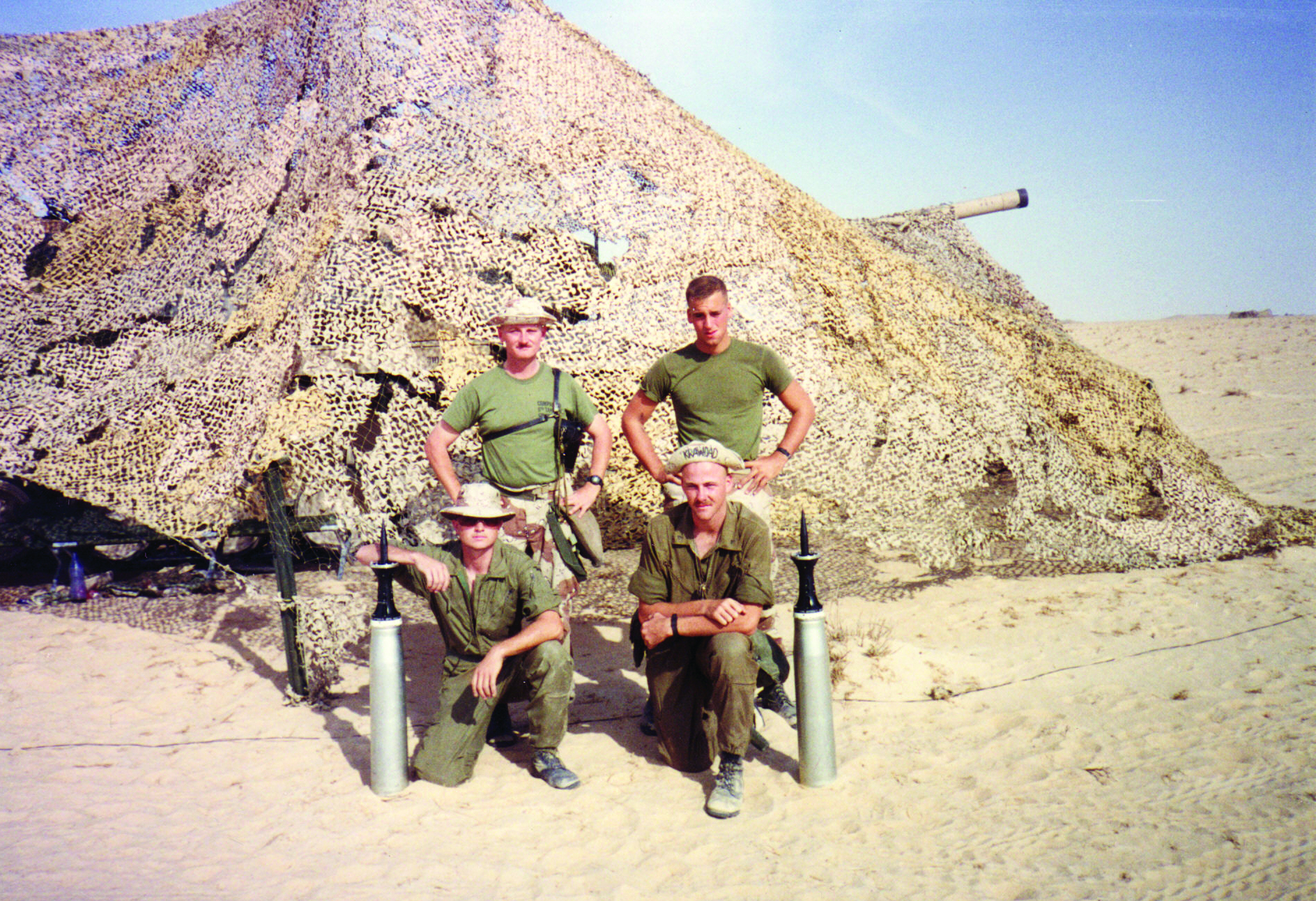
Genesis II’s crew standing in front of the tank. It was concealed under radar-scattering camouflage netting with its main gun barrel protruding. From top left, clockwise: Capt Ed Dunlap, Cpl Sean Pulliam, LCpl Sean Gardner, and Cpl David Schmidt.
Courtesy of Ed Dunlap.
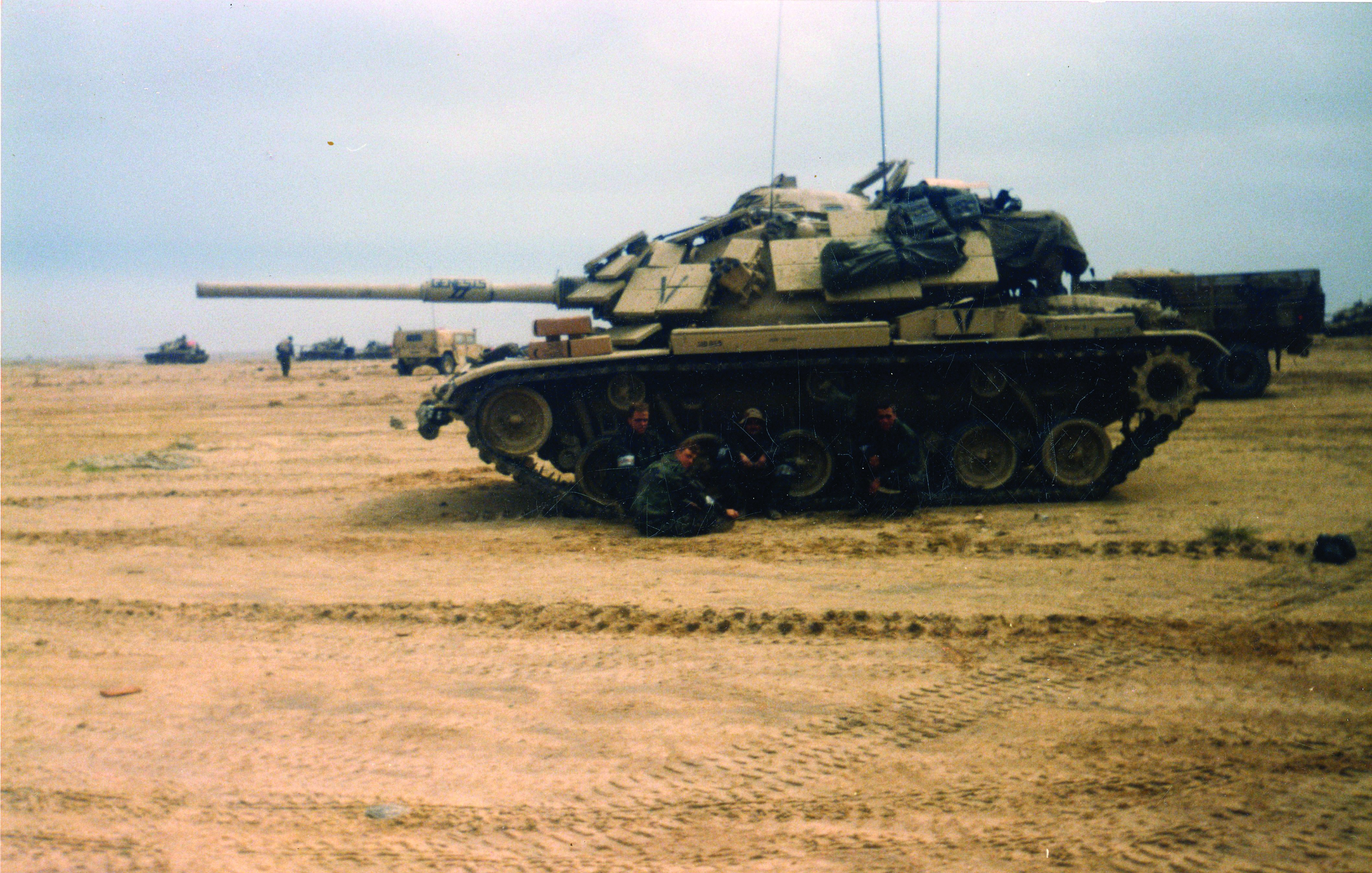
Genesis II and crew somewhere in Kuwait waiting to cross the line of departure.
Courtesy of Ed Dunlap.
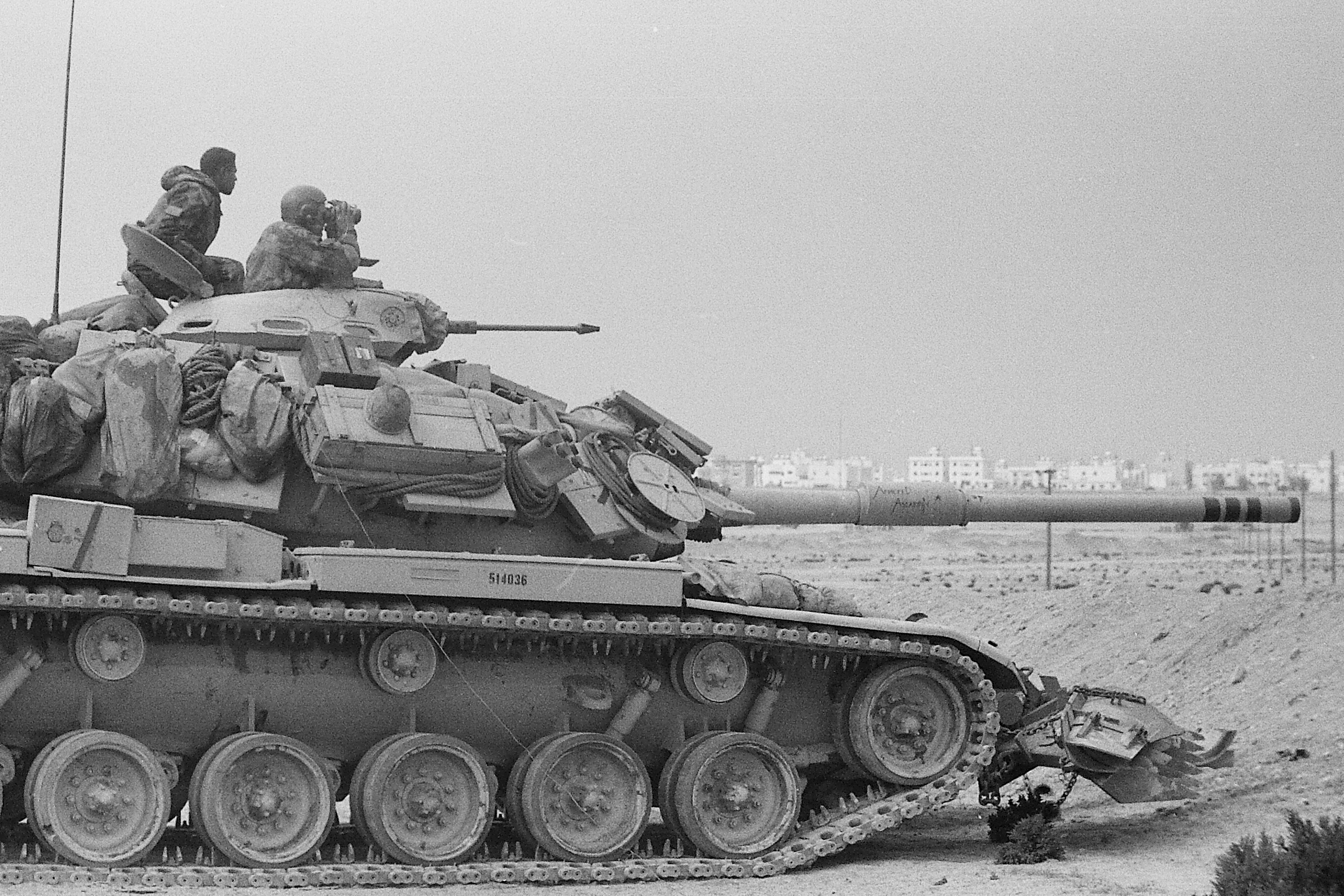
Marines of the 3d Tank Battalion outside Kuwait City at Kuwait International Airport. This tank was fitted with a mine rake as a measure to help clear the minefields that the Marines encountered during the ground assault.
Courtesy of Michael O’Neal.
After securing Ahmad al-Jaber Air Base, TF Ripper oriented its attack toward Kuwait International Airport. However, the Iraqis launched a counterattack, which the 3d Tank Battalion fended off before resuming the advance. By the evening of 25 February, the 1st Marine Division approached Kuwait International Airport. Smoke from pervasive oil fires slowed the Marines’ advance, forcing them to wait until the following day. Another set of obstacles to traverse and continued poor visibility meant the Marines could not surround and fully secure the airport until the morning of 27 February. There, the Marines paused while a joint Arab military force liberated Kuwait City. Major General Myatt then waited for word of a ceasefire or orders to begin an attack on the Iraqi capital of Baghdad. But the assault on Baghdad was not to be. Early on the morning of 28 February, President Bush ordered a ceasefire after it had become clear that the Iraqi military had been thoroughly defeated.
During Desert Storm, the Marine Corps sent a team of historians to scour the area for items to preserve for posterity. They chose to send back to the United States a Marine Corps M60A1 main battle tank called Genesis II. The M60A1 is a relic of the Cold War, entering service with the U.S. military in 1959. Genesis II was chosen because its tank commander led Company C, 3d Tank Battalion, the lead tank company to cross the border into Kuwait.
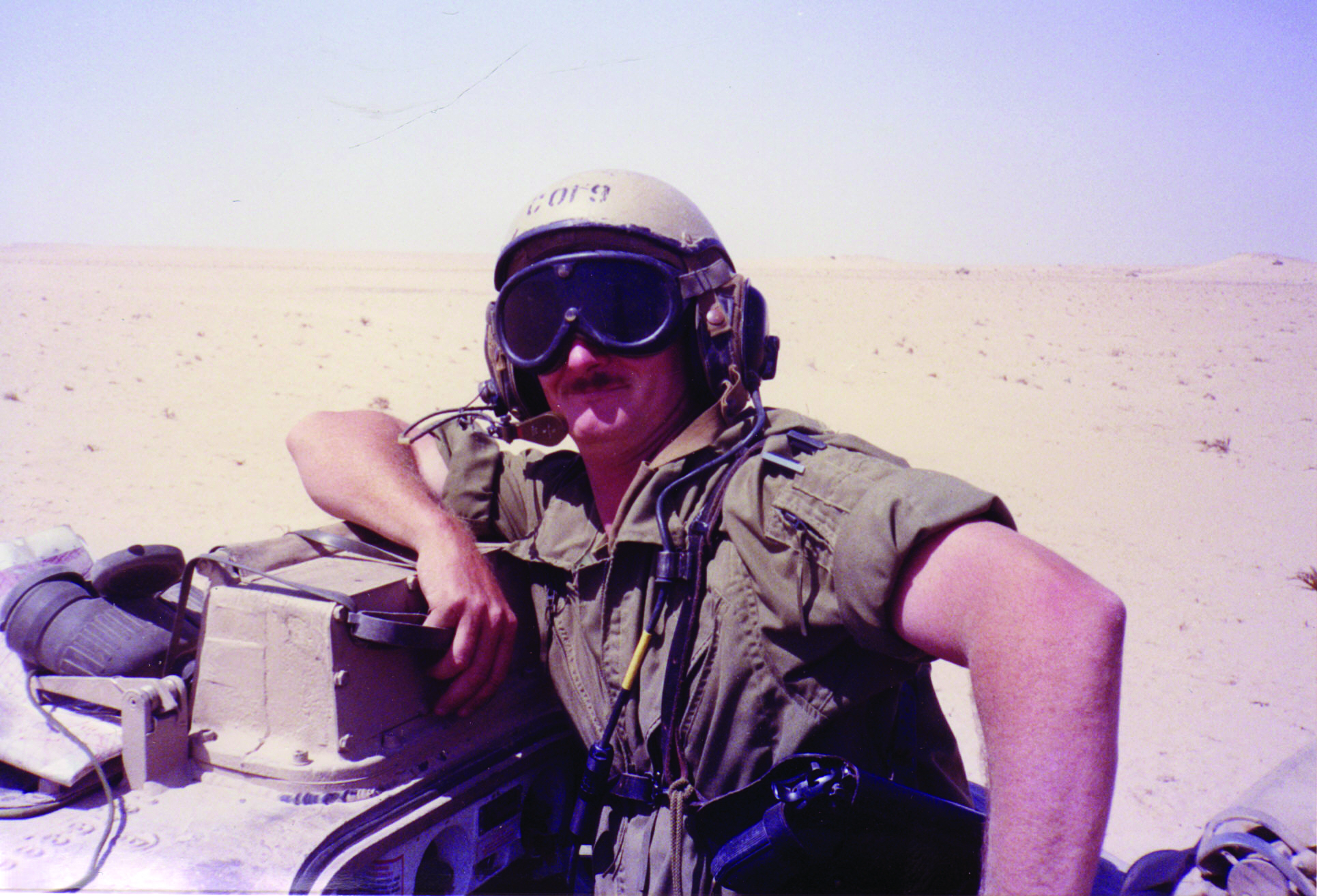
A photograph showing Capt Dunlap’s resemblance to the Genesis drummer Phil Collins.
Courtesy of Ed Dunlap.
According to the crew Genesis II, company commander Captain Ed Dunlap resembled Genesis lead singer Phil Collins, so they chose to name their tank after Collins’s band. The crew also painted “Shoot-N-Loot” on the tank’s gun barrel as a tongue-in-cheek reference to their instructions that they were going to Kuwait to liberate the country and not to shoot at and loot the populace.
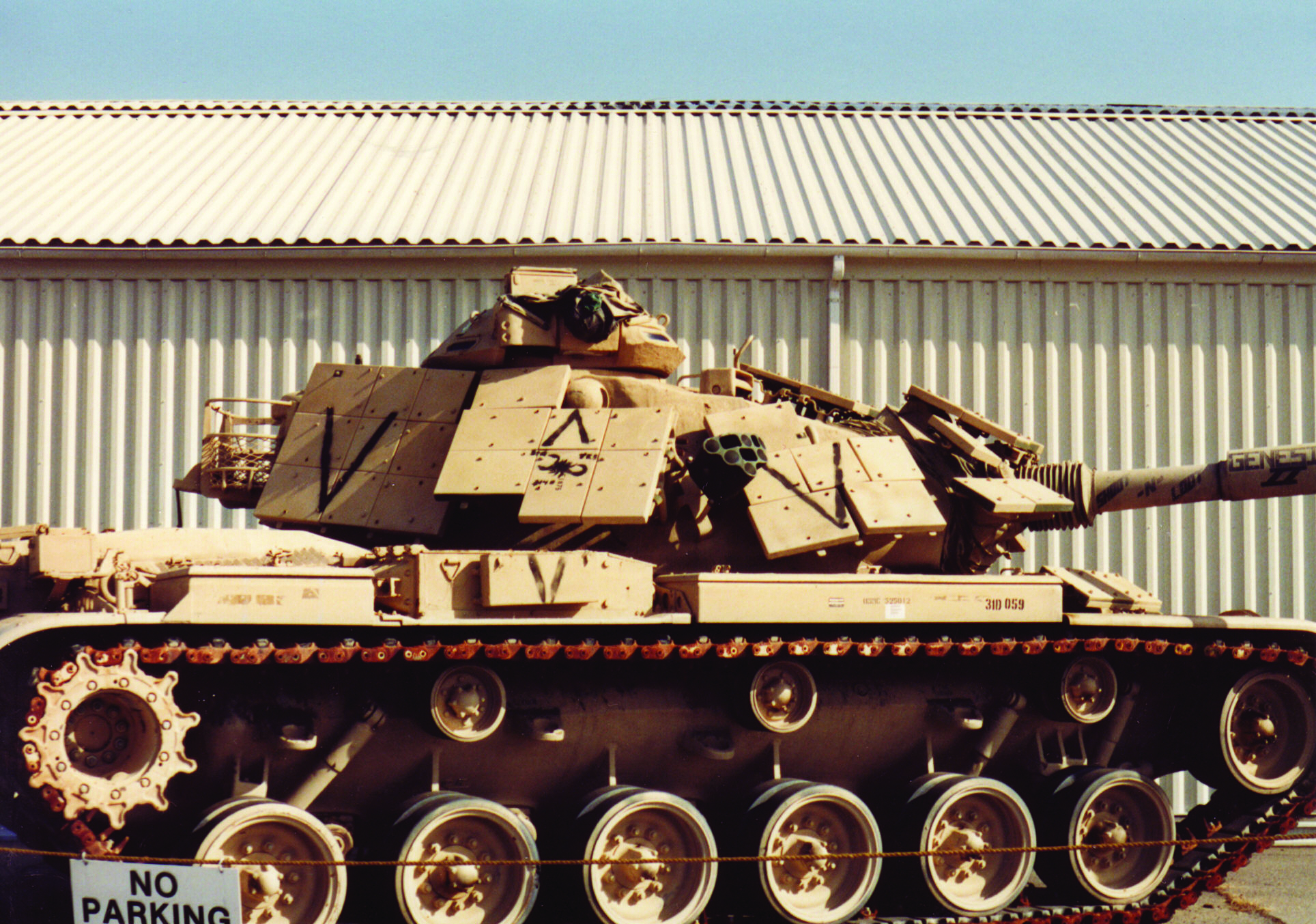
Genesis II parked outside of the Marine Corps Air-Ground Museum at Quantico, ca. 1992.
National Museum of the Marine Corps.
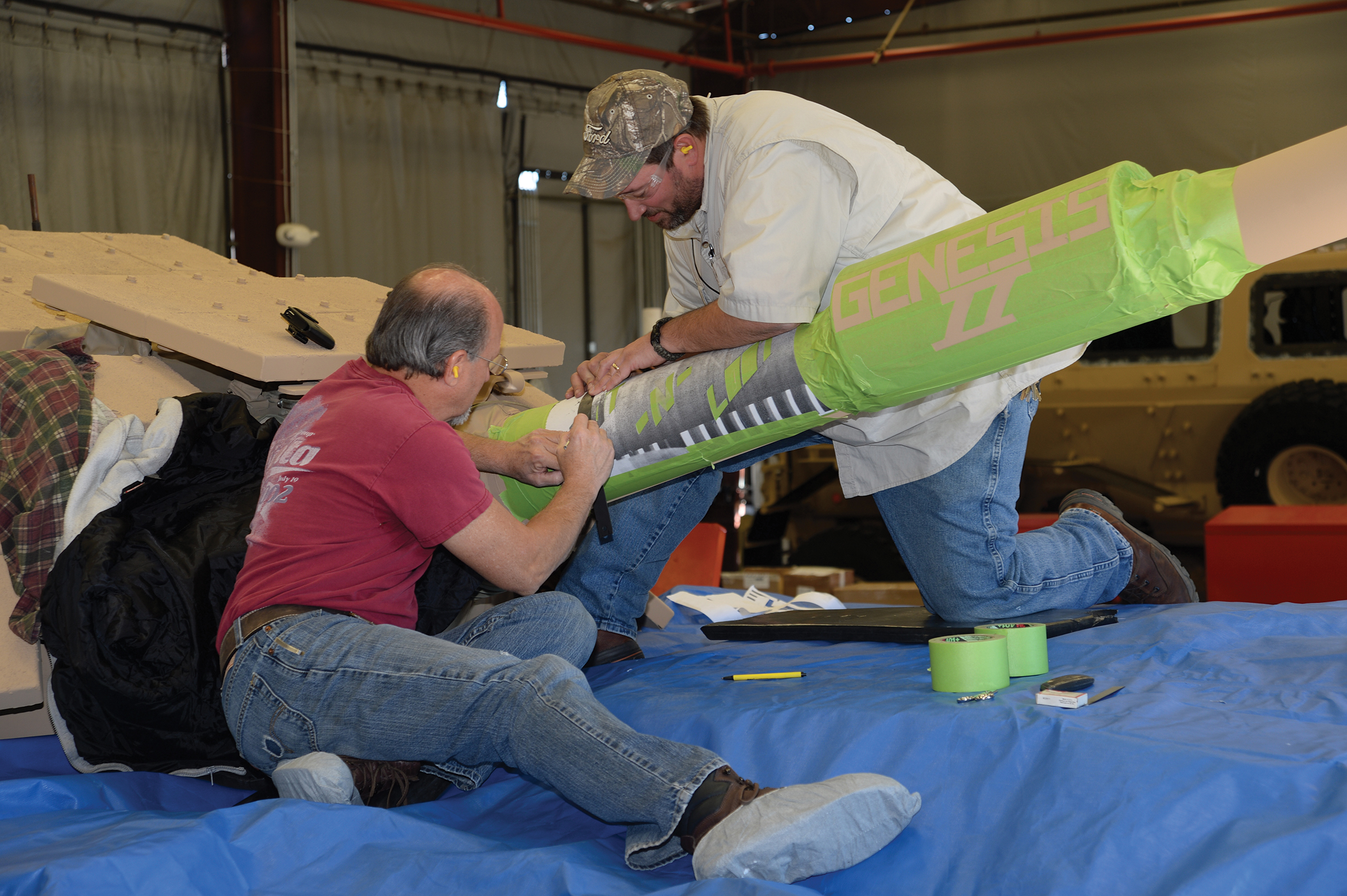
David Tucker (left) and Jamie Green (right) prepare to stencil “Shoot-N-Loot” back on Genesis II’s barrel.
Photo by Mardi Reese.
Genesis II is not the only M60A1 tank preserved as a museum piece by the Marine Corps. 3d Tank Battalion commander Lieutenant Colonel Alphonso “Buster” Diggs’s tank has also been preserved. This tank, called Buster, is preserved and currently on loan to the U.S. Army Armor and Cavalry Collection at Fort Benning, Georgia. Before becoming part of the collection of the National Museum of the Marine Corps (NMMC), Buster stood as a monument in front of the Marine barracks at the U.S. Army Armor School at Fort Moore, Georgia, before the Marine Corps eliminated tanks from its inventory as part of its Force Design 2030 force restructuring plan.[1]
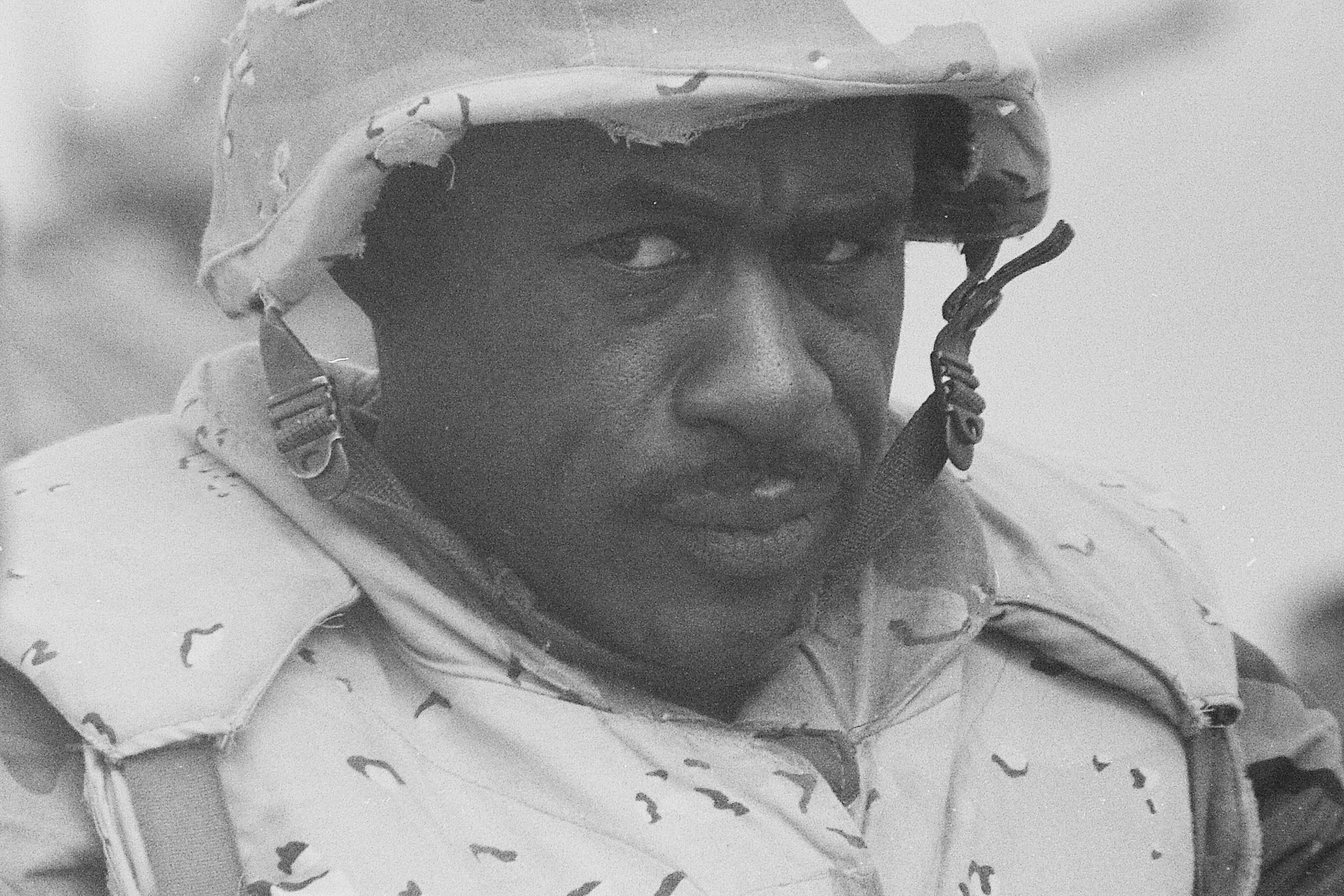
LtCol Alphonso “Buster” Diggs commanded the 3d Tank Battalion, the armor component of Task Force Ripper, during Operation Desert Storm. His M60A1 tank, “Buster,” is on loan to the U.S. Army Armor and Cavalry Collection.
Courtesy of Michael O’Neal.
The Marine Corps deployed these Cold War-era M60 tanks to the Persian Gulf in support of Desert Storm. For the U.S. armed forces, Desert Storm was the first—and last—hurrah for the M60 in major combat roles. The Marine Corps upgraded their M60s to improve their accuracy and survivability and included passive night vision sights for the gunner and tank commander. The M60s deployed during Desert Storm featured explosive reactive armor, which exploded when hit to dissipate the destructiveness of an antitank round. The M60’s main armament was a 105-millimeter main gun, compared to the 120-millimeter main gun on the U.S. Army’s M1 Abrams main battle tank. The Abrams was also faster, more reliable, more survivable, and presented a smaller silhouette. Immediately after returning from Kuwait, the Marine Corps purged the M60s from its inventories and completed the transition to the Abrams. The 3d Tank Battalion was deactivated in the summer of 1992.
When Genesis II came to the old Marine Corps Air-Ground Museum in Quantico, Virginia, it sat outside in the humid environment, causing some corrosion problems and paint damage. Because of the corrosion, Genesis II needed to be restored. The NMMC developed a partnership with Marine Depot Maintenance Command (MDMC) in Albany, Georgia, to complete the restoration. The NMMC has worked with MDMC for other restoration projects in the past. The crews there understand the museum’s exacting standards and have always exceeded its expectations.
The newly restored Genesis II arrived at the NMMC in September 2016. It took two days for riggers to place the tank on its mount. Genesis II was the first artifact installed in the museum’s Final Phase galleries, which interpret Marine Corps history from 1975 to 2015.
Endnotes
[1] Gen David H. Berger, Force Design 2030 (Washington, DC: Headquarters Marine Corps, 2020).